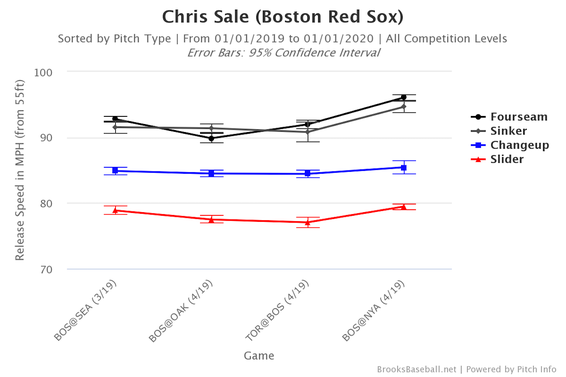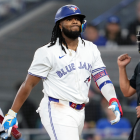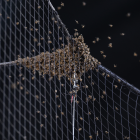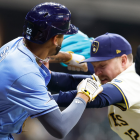Here's one thing that's gone right for the Red Sox this season: they edged the Rays on Friday (BOS 6, TB 4). Of course, that just means they're now 7-13 and a full seven games off the pace and in last place in the AL East. To boot, the Sox on Saturday placed right-hander Nathan Eovaldi on the injured list with a loose body in his elbow (perhaps helping explain his 6.00 ERA after four starts).
No doubt the 2019 season has not gone swimmingly for the defending champs. In addition to all those more pressing concerns, they're also presently lugging around a run differential of minus-40, which is the worst mark in the AL by a wide margin. All of that's been amply chronicled in these early weeks.
Now, though, let's pivot and point out a few things that have gone right for the Red Sox in 2019 -- some of which may augur better days ahead for Alex Cora's squadron. Forthwith ...
Price is still good
In terms of run prevention, David Price in defiance of all the hand-wringing hasn't had a bad season since signing a $217 million contract prior to the 2016 season. Health has been an occasional concern, and postseason performance was very notably a concern until last year. Overall, though, Price has done his job on Boston's watch, and that's still the case in 2019:
That comes to an ERA+ of 120, which is a tick better than his overall Boston career to date. As well, Price is presently running a K/BB ratio of 6.67 and striking out 27.4 percent of opposing batters -- career-best numbers, both. He's also averaging more than six innings per start, which is a notable figure these days, and his average Game Score of 58.7 (Game Score is a quick-and-dirty Bill James metric that measures a pitcher's dominance or lack thereof in a given start -- 50 is average and anything 90 or higher is an absolute gem) is highest since before he signed with the Red Sox. Price is now 33, but he hasn't slipped.
Bogaerts hasn't let up
Much has been expected of Xander Bogaerts since he began cracking top-10 overall prospect lists in 2013, and last season he truly busted out with a 135 OPS+ and a WAR of 3.8 for the champs. That's the kind of production that's long been expected from the shortstop, and it no doubt informed the team's decision to offer him a $120 million contract extension (which Bogaerts accepted). He's now toe-deep into that extension, and he hasn't missed a beat since last season:
Bogaerts has also drawn 10 unintentional walks against 14 strikeouts, and his current OBP of .380 if it holds up would easily be a career high. We know he's got the power upside (71 extra-base hits in 136 games last season), and now the 26-year-old is adding to it an improved command of the strike zone. That's the kind of thing that becomes meaningful pretty early in the season, and it bodes well moving forward.
Brasier is looking like the answer at closer
Brasier added velocity, which helped him at at age 30 salvage a big-league career that almost barely got started. Now with Craig Kimbrel in the free agency hinterlands, Brasier has emerged as the Boston closer this season. He's saved four games in five chances at this writing and put up impressive numbers along the way:
Brasier boasts a 4.50 K/BB ratio and an ERA+ of 239, and he's done all that despite facing left-handed batters almost 60 percent of the time thus far in 2019 (increase use of his changeup has helped neutralize that mini-trend). Yes, it's early to be touting reliever outcomes (it's early to be touting any outcomes), but Brasier has been nothing but dominant across 44 relief appearances on Boston's watch. He's now 31, but with pitchers it's more about skill retention than age, and Brasier isn't eligible for free agency until after the 2023 season. The Sox may have their post-Kimbrel answer at closer for years to come, and if things continue to go south in the standings they may have a valuable trade piece once the July 31 deadline creeps onto the radar.
Betts is probably in for better days
Right now Mookie Betts, the reigning AL MVP, has an OPS+ of 99 (.214/.314/.432). That's playable when you consider that Betts adds value in the field and on the bases, but it's well below his established standards. He's still just 26 so absent underlying injury there's no reason to think these are the early hours of some kind of premature decline.
Indeed, if you poke around a bit, it seems likely that Betts will find his level in the coming days and weeks. His batting average on balls in play is just .214 versus a pre-2019 career mark of better than .300. That's a statistic prone to random variation, especially with pitchers. When you see hitters of prime age sloughing off 100 points or so in the early going, you can also assume bad luck is the primary driver.
As well, there's an advanced metric called expected weighted on-base average (xwOBA). xwOBA grows out of wOBA, which assigns proper value to every possible offensive event that happens while a batter is at the plate. Those proper valuations of singles, doubles, homers, walks, etc., distinguish wOBA from more traditional measures like AVG, OBP, and SLG. Also, for simplicity wOBA is scaled to look like OBP, which means that, say, .400 is elite and .290 is pretty poor. For instance, Babe Ruth is the all-time leader with a patently absurd wOBA of .513.
All of that brings us back to xwOBA, which is an estimation of what a hitter's wOBA should be based on things like exit velocity off the bat and launch angle. xwOBA attempts to strip away luck -- bad or good -- and defensive play from wOBA and identify a hitter's baseline skill. It's useful for getting an idea of how a hitter figures to perform in the near-term future. Basically, if a hitter's xwOBA is significantly lower than his wOBA, he's probably going to come back to earth at some point. In Betts' case, his wOBA at the moment is .319, but that's compared to a current xwOBA of .349. If he finds that .349 level on a sustained basis -- not an unreasonable assumption -- then he'll produce roughly in line with his levels of 2015, when he put up a WAR of 5.9 and even popped up on a couple of MVP ballots.
Vazquez could be the guy at catcher
The Red Sox's catching situation is such that last year's primary, Sandy Leon, started off the season in the minors and is now the backup. Blake Swihart, another hypothetical option, was DFA'd not long ago. That means starting duty has fallen to 28-year-old Christian Vazquez, and in the early going he's mostly delivered. He's not getting on base, but he's popped four homers in 15 games played and is slugging .531 at the moment.
Even if those power outputs don't hold up (they probably won't), he's also looking like a strong defender in the early going. According to the advanced catcher metrics at Baseball Prospectus, Vazquez through 108 2/3 defensive innings this season has looked like one of the AL's strongest defenders. In particular, Vazquez has distinguished himself in terms of pitch-framing, and he's also throwing out runners at a better-than-average clip. Plus catch-and-throw skills in addition to the ability to occasionally run into at the plate could make the 28-year-old Vazquez a solution at catcher for Boston.
Sale had a velo rebound last time out
There's no disputing the depths of Chris Sale's 2019 body of work to date:
But let's focus on a positive takeaway from his otherwise undistinguished start against the Yankees (5 IP, 4 R):

That, folks, is a velocity rebound. In Sale's second start of 2019, he fastball velocity plummeted to below 90 mph on average, but on Tuesday against the Yankees it spiked to better than 96 mph on average. In terms of velo, that's vintage Sale, and that he was able to get back to such levels is an encouraging sign. In not unrelated matters, Sale struck out a season-high six batters against New York while walking only one. The 2019 script on Sale won't flip until he proves capable of keeping runs off the board on an extended basis, but the return of his vintage radar-gun readings is absolutely a positive.
It's still early
Here's the big thing. It's still April. At this writing, the Red Sox still have 87.7 percent of their regular season schedule left to play. That's plenty of time for them to find their level and put heat on the Rays (and perhaps Yankees) by the time we get deeper into the summer.
To spin that forward, let's get an assist from the SportsLine Projection Model (@SportsLine on Twitter). Right now, SportsLine projects the Red Sox for 93.6 wins (it's an average of thousands of simulations) and gives Boston a 59.5 percent chance of making the postseason. That's down significantly from their projected wins and playoff odds coming into the season (such is the nature of losing 13 of your first 20 games), but SportsLine remains bullish on the Red Sox over the rest of the season. As noted, "the rest of the season" comprises the vast majority of games on the schedule.
There's still plenty of time for Boston to mount a vigorous defense of belt and title, and in part because of the reasons laid out above they may yet do that.





























